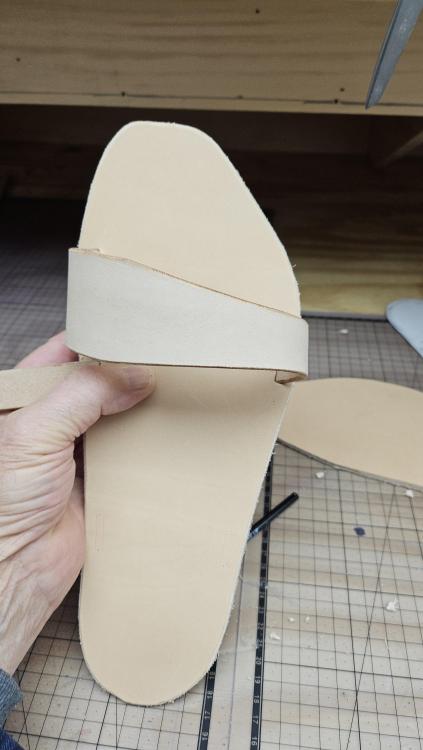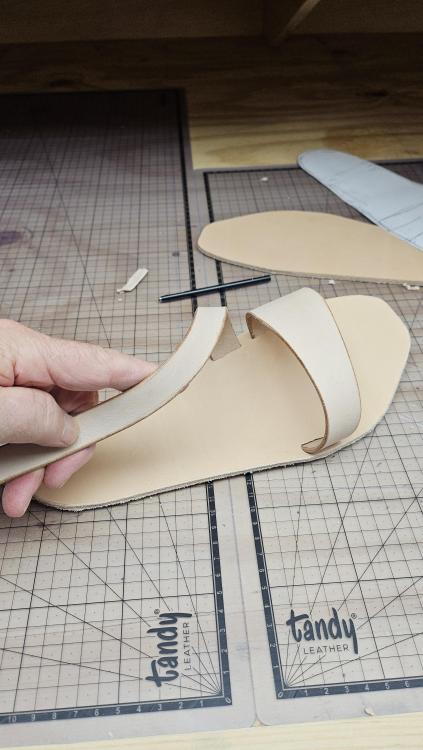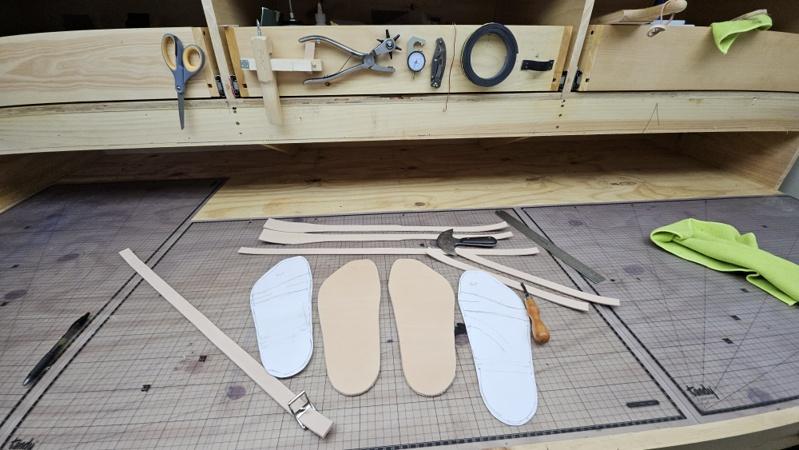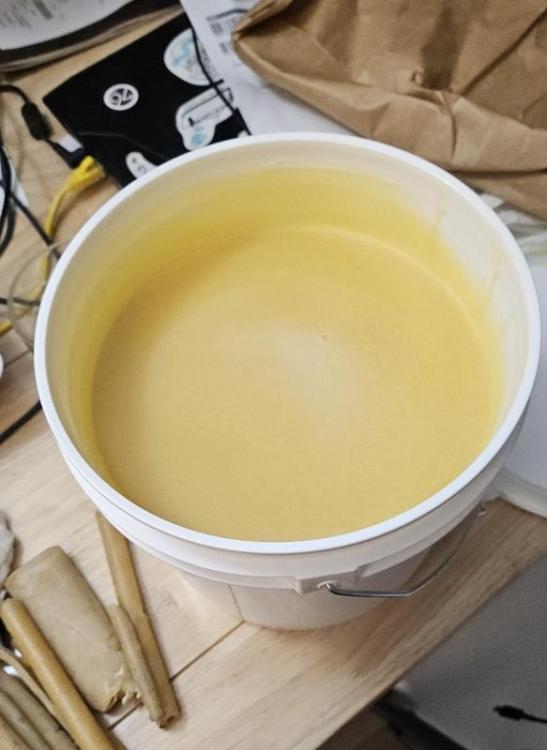
deboardp
Contributing Member-
Posts
189 -
Joined
-
Last visited
Content Type
Profiles
Forums
Events
Blogs
Gallery
Everything posted by deboardp
-
-
OK so I had burnished those straps in the previous post. Today I cut some slots in one of the topsoles and realized I need a couple tools, for the ends of the slots, which probably need to be rounded to match the burnished strap edges. So that would be a circle knife, sort of like a round punch, but very thin like my round knife's thinness, because a typical punch spreads the leather, and I don't want to do that. A half-circle knife would be better, with diameter of 1/8", because I want to carefully cut the slot ends out. . It probably does not exist since slot punches always go straight down and through a leather topsole. But I'm doing 45 degrees, to set the angle for the strap going under the edge of the foot. The strap will lay flatter and be more comfortable if the slot is angled. Anyways here's a picture. Maybe you can understand what I'm setting. The slots are rough because I was using my round knife and removing leather from the two ends of the slots is difficult withOUT a circle knife.
-
I've been thawing the pork leaf fat and smelled it. It has almost no smell at all, maybe only a couple molecules that remind me of smoked pig hocks. It's pure white, rough textured. The plastic 2 lb container says it is "pork leaf fat, refined", whatever that means. I think it needs to be melted in order to be rendered, but that's a guess. The second delivery is Wagyu Beef Tallow from South Chicago Packing. It is white and looks super saturated, dense looking. Like the pork leaf fat it has maybe one molecule per inhalation that suggests beef source, but neuter of these very slight smells was unpleasant. In fact I had to inhale deep and concentrate and think, is that a smell? This particular tallow reminds me of Crisco. The first one I bought, in a14 oz glass jar is Fatworks Pure Tallow, Organic Cooking Oil, a yellow solid that smells like hamburger run off. I question whether this one is derived from leaf fat of the animal. I don't plan to use it. I'm making progress on a pair of sandals for myself. I'm using some processes I didn't use 50 years ago, so despite having a list of ten people who want a pair, I'm making mine first, to make sure I've got a handle on those processes. Burnishing, 45 degree slots rather than straight through at 90, middle with channels cut out, machine stitching, stuffing with fats, lanolin and wax, gluing the gum rubber on the bottom without stitches or tacks... The third product that came is the Norwegian cod liver oil, processes to remind impurities and the smell. It has maybe one molecule of fish smell, and that's debatable. Essentially free of smell. The three of them actually. I had to be really nosey to smell anything. Just stick my nose in it, practically. OK, I'm off to update my sandal progress in that other thread in the Show Off forum. Check it out! I'll make a list of who sells these odor free products when I find one of the three invoices.
- 193 replies
-
- saddler recipe
- diy conditioner
- (and 4 more)
-
I read somewhere that oils and fats go rancid when they are exposed to air. But if they are inside a piece of leather, there's no air in there. Also historically, FOR CENTURIES, fats in the form of tallow and lard have been stuffed into leather used by saddlers. If their saddles stank of dead meat, for sure the ladies would have said something, if the men didn't. One saddler said that cod liver oil rubbed onto fat- stuffed leather restores the smell of leather. I had quoted that a fellow said his leather stank after he used lard, but he had made a false statement about something else, so I no longer believe anything he has to say, about anything. Therfore I'm inclined to use the pork leaf fat that was delivered just now. I think I have to render it myself. I'll investigate that situation later, while it thaws.
- 193 replies
-
- saddler recipe
- diy conditioner
- (and 4 more)
-
I don't remember if I mentioned here at leatherworker.net that the VA approved my claim for disability compensation for acquiring disabling diseases due to herbicide exposure, but they did, about December 13th. I won't be homeless again, which at 77 is a matter of survival. I also don't have to make sandals now, but I want to, having spent the last 16 months setting up my shop, and today I am at this stage where the topsoles and straps for my very first pair since the 70's are cut and beveled. After I click send I'm going to burnish the strap edges with trag and start on the strap slots. I'm not using a punch for that, but will use my round knife and tiny circle punches and will make the slots 45 degrees rather than 90. I'll stitch on either side of the slots to strengthen the glue bond between top and midsoles. Progress!
-
Yeah, that one.
- 193 replies
-
- saddler recipe
- diy conditioner
- (and 4 more)
-
I see two Golden Mink Oil products by Fiebing, on tandyleather.com: GMO Preserver and GMO Liquid. Since you mentioned the base being petroleum jelly, it must be the Preserver that you use. I thought I would pick up a jar of it, just in case.
- 193 replies
-
- saddler recipe
- diy conditioner
- (and 4 more)
-
Did you render it or did it come rendered?
- 193 replies
-
- saddler recipe
- diy conditioner
- (and 4 more)
-
Can somebody suggest the best order for performing the following tasks: Creasing edges Applying dye Burnishing edges of straps and soles Stitching the soles by machine Stuffing the straps and top sole with fats and wax I'm especially wondering if I should do the stuffing before I sew, because I thought the stitches might sink below the surface a little bit if the leather is stuffed, which would be more comfortable probably, for the feet. Also I was wondering if I should burnish after I sew, because maybe the leather being squeezed by the stitch would cause the burnished edge to open a crack. I've never sewn my sandals, always cobbled.
-
thank you for this! I was sad about the tallow smelling like a short-order cook's apron in a biker bar. Why? Because tallow is supposed to be excellent for stuffing veg tan leather after it is tanned. Tallow has excellent properties for long-lasting lubrication of leather fibers, all of which I have totally forgotten. (I can do all kinds of things really well, but remembering is not one of them.) I really wanted to use tallow. Now, it appears I can! I'll break out the spaghetti pot, throw that tallow in there and cook it like a pot of 15 bean soup. (Not spaghetti, the thin stuff takes only ten minutes.) If it is really odor free, then the formula of my recipe will be excellent. Maybe, I mean. Tallow, a little beeswax (the Abbott of the monastery gifted me a block of it), lanolin... macadamia oil, just a little. I wonder if I can do the same with the lard that's due any day now? Why not, huh? However, doesn't the question remain, the question being: Will tallow, even odorless tallow, go rancid in the leather? Or does the rendering in the pot make it immune to decomposition? At one time when I was a hippie, I worked in a hippy and biker bar. We got along, the hippies and the bikers, although the bikers kept to themselves mostly. We tolerated each other but didn't really intermingle that much. Bikers are really different. I don't mean social clubs that ride bikes, but hard-core bikers, drug-dealers, criminals, like that. It was like serving beer and burgers to vipers, I always tread carefully, not knowing if I'd get bit (never did). I cooked, and I tended bar. They tolerated me. I made a great truck burger, hard to eat the thing. A shovel would have helped. Nobody complained. I'm trying to translate that... your clients are a rough crowd who don't care about stinky grease? But why would you grease the grip on a black powder cannon? Haha. The monks are ascetics. they fast half the days of the year, I think, don't eat meat ever, they get up at 3:00 in the morning for a 3 hour church service, and they work 6 hours a day in various capacities. They also have church at 9:00 (20 minutes), 4:00 (45 minutes) and 6:15 (30 minutes). Vigils on Saturday go from 6:15PM to 10:30PM. They bathe and sleep when they can, but no showers are allowed. I've never asked how they clean up, but I've camped quite a bit, especially the 15 years I was homeless, and it's possible to more or less wash up with very little water and some soap. Some of the monks, in the summer, smell a bit ripe from time to time. I did ask the priest if it would be okay to use tallow and lard, and he said whatever works. Apparently the monks who will wear my sandals are not planning to eat them, but if one of them does, then the priest might rescind his blessing to use animal products. Thanks for jotting down all this information! I knew you were holding something, Chuck. PS What the heck is brain tanning??
- 193 replies
-
- saddler recipe
- diy conditioner
- (and 4 more)
-
How was that off topic?? It's exactly what I want to hear! Yeah, if it won't keep in a balm tin, forget about it! ScottWolf mentioned that lard turned on him, too.
- 193 replies
-
- saddler recipe
- diy conditioner
- (and 4 more)
-
Wax is only 25% of the recipe from Austin "Oz" Black, the Welsh saddle-maker, which he says is based on the traditional formula for "English saddler's grease". I think I'll use just a bit of it.
- 193 replies
-
- saddler recipe
- diy conditioner
- (and 4 more)
-
Holy Smoke! Somebody in Paris, France is making and selling a conditioner made with the same ingredients I am thinking of using! Lanolin, beeswax, and macadamia nut oil! Look at this!
- 193 replies
-
- saddler recipe
- diy conditioner
- (and 4 more)
-
I copied and will paste here a post by TinkerTailor from Nov. 26, 2015, from the thread on leatherworkers.net. It's fascinating and has a link to a 217 page digital book from the past, that has been preserved for us. From TinkerTailor: I got alot out of this book: The recipes in it obviously take ph into account based on application. Get out your bucket of spermaceti, your rape oil, and that stash of caoutchouc, Its time to make some leather dressing! Did you remember the brown sugar? I give you: "The manufacture of lubricants, shoe polishes and leather dressings" https://ia600404.us.archive.org/1/items/manufacturelubr00brungoog/manufacturelubr00brungoog.pdf All page numbers i list are pdf page numbers, not the original page numbers. Page 29 of the pdf, they talk about the ph of oils and how it changes as it rancidifys due to the presence of free fatty acids forming. It also clarifys what are called neutral oils, which are oils that do not have the free fatty acids in a fresh state which change the ph, such as rapeseed(canola) oil as well as olive oil. They imply that some oils have the free fatty acids when fresh and are unsuitable for use with metal due to corrosion issuesdue to Ph. I would imagine the same thing applys to leather. They also get into drying vs non-drying oils, linseed oil, for eg, is a drying oil and is not very suitable for a lubricant and presumably a leather dressing, while it is used in recipes for leather varnish. Page 102 is a writeup on neetsfoot oil and a comment about how many sewing machine and clock oils are bleached neetsfoot repackaged in tiny bottles and marked up. pg 119 is the recipes for the fine machine oils. They also talk about freezing neetsfoot and straining out the oil that is still liquid to purify it. Also bleaching it in the sun using violet glass.....Had they discovered uv treatment? They did notice purple glass bleached it better for some reason. Page 114 is an interesting recipe for leather belt dressing to prevent slip made from ~90% castor oil and 10% tallow. Page 142 is where the good stuff starts. The stuff relating to leather. You will notice that many of the recipes for shoe polishes etc contain sulfuric acid or soda, Presumably to make them strong enough for a man but Ph balanced for a woman.........Or is that deodorant?....rabbit holes are fun.........squirrel Page 148 talks about ant-acid boot leather varnish .....acid free....The effects of ph on leather were DEFINITELY known at this time. I have from my reading determined that as a leather treatment, tallows are the best treatment for lubricating the fibers and preserving the leather for a long time, however they are hardest to apply due to being mostly solid at room temp. Tannerys hot stuff tallows and waxes to make that expensive horween stuff. Temperature and exposure time are needed for the leather to take up the fats fully. These processes are out of the reach of the average user as they require special equipment and machinery and is better done in bigger batches of hides. The tallow lubricates, and the wax protects. Both are very long lasting before breakdown, if it even happens. We as leatherworkers try to approach this on raw leather but without the prolonged heating and tumbling. Oils are the best solution to make leather treatments that are easy to apply. In order to apply the harder waxes and tallow, we often mix then with thinner oils to make easily appliable pastes and cremes. In my opinion,Neetsfoot oil has won over many as the oil of choice for a few reasons: 1: The general availability and cheapness of neetsfoot oil as well as its suitability for leather in that it is non-drying, long lasting, and has a long shelf life 2: It is easy to apply. It can be used to make waxes and tallows thinner and possible to apply at room temp 3: The US army chose it. 4: It works in most of the situations leather is used as an adequate dressing. 5: Grampa used it, and so did his grampa......so did stohlman and some other saddler guy..
- 193 replies
-
- saddler recipe
- diy conditioner
- (and 4 more)
-
I was thinking about the recipe just now. The tallow smells of hamburger grease, and the pork lard probably smells of pork chops, and I'm thinking, why do i want to put this stuff in my leather??? OK, it's fats, but it stinks! According to old English saddler's grease recipes, the cod liver oil is supposed to restore the smell of leather. Is that because it cancels out the mIteat stink? Sheesh. So, I want to use things that don't stink or overpower the natural scent of vegetable tanned leather because that stuff smells wonderful. Therefore, I'm shelving the animal fats for now. When the Norwegian odorless cod liver oil arrives, I'll shelve it as well. Therefore, I have beeswax, lanolin, macadamia nut oil on the way. Is there another fat I could use instead of the ones from animals? I prefer to not use man-made fats, and I don't have a reason I can articulate, yet. My primitive thinking on this is to put cup portion of lanolin in the small pot over a low heat, add half a portion of beeswax, I guess by volume, and see how it melts, maybe a couple tablespoons of macadamia oil... If it all gets along with each other, then I'll put some in these tins I got from Bulk Apothecary bulkapothecary.com where I also bought the lanolin. Chuck, can you share your recipe for conditioner? You seem to know about it, and I'm interested. What kind of projects/products do you use it on? I think beeswax, lanolin, and macadamia nut oil might smell really nice, on top of the leather smell. I worry about oils going rancid, so I googled, "will macadamia nut oil go rancid in leather" and figured, ha, nobody will have an answer to that! I was surprised to see that this is the very top result of the google search: click here Fascinating. I read the OP's post and will return now to read more. The target audience is for leather workers with organic chemistry background or a scientific bent, which is us, since we're interested in making a concoction that has chemical properties.
- 193 replies
-
- saddler recipe
- diy conditioner
- (and 4 more)
-
An emulsion. That's how the water can easily evaporate. The water acts as a medium to help the fats/wax/lanolin compound get into the leather and then exits, leaving the compound in the leather. Brilliant! My tallow came. It smells like hamburger fat, is yellow like lanolin.
- 193 replies
-
- saddler recipe
- diy conditioner
- (and 4 more)
-
As a remodel contractor I occasionally installed butcher block counter tops. To protect them from food and stains I finished then with food grade mineral oil. I would put it on the wood and using microfiber cloth I would rub it into the wood until it was well absorbed. I did this the next day and the next. That wood absorbed a lot of oil. If wood will absorb it, vegetable tanned leather will inhale it, as it is way more porous than wood. To finish here, are you using liquid mineral oil. Vaseline is closely related to MO, but it is solid. If you put that on veg tan leather it won't absorb, probably. Are you using liquid or solid? Can you post a picture of what you're using, and a picture of the leather you're using, before and after applying the MO?
- 193 replies
-
- saddler recipe
- diy conditioner
- (and 4 more)
-
Nobody is rejecting you. Maybe ask Chuck if he used vegetable tanned leather. is that what you used? Leathers with finishes probably won't absorb mineral oil, but veg tan leather will. It's just a fact and has nothing to do with our personalities and characters personally. It's just science. What works, what effect does this have if we do this. I think you might be using something other than vegetable tanned leather to support your observation that MO stays on the surface. I've heard there's oil tanned leather which I know nothing about. I suppose MO might stay on the surface of that type of leather. Surely there's an explanation for the discrepancy between your observation and chuck's. I haven't poured MO on a scrap piece of leather like chuck surely did, and I'm not going to. If i poured any kind of oil on a scrap of my leather sides i know it will soak in immediately. That's the nature of veg tan. There's no oil, fat or wax anywhere in it. Everything was removed during tanning.
- 193 replies
-
- saddler recipe
- diy conditioner
- (and 4 more)
-
He was checking your statement that leather doesn't absorb MO. Take a breath Scott. It's not about you.
- 193 replies
-
- saddler recipe
- diy conditioner
- (and 4 more)
-
I don't know of wax oil mixtures. Oil is liquid by definition. Wax and fat is what I am using, both are solids, and lanolin is missing something that is required for a substance to be called a fat, but it's solid and fat-like. So, my leather conditioner does not have any oil in it. Just wax, tallow, and lanolin. I am essentially making my version of old English saddler's grease. I'm also going to follow the procedure that unicornleather (last seen here in 2020) wrote down for us in his post here at leatherworkers.net: leather conditioner.odt The procedure calls for wetting the leather with warm water and then rubbing the grease into all the surfaces of the leather, front, back, edges. I read it somewhere, that warm water causes leather to open its pores, thus the hand-rubbing and massaging of the grease is forced into these pores, is pushed into them. The rubbing creates heat, which helps the grease to get thinner and go farther into the pores and spaces between the fibers. I suppose that the grease and the water can mingle, mix, and maybe become a homogeneous compound. I'm eating homemade pea soup as I type this, and I put a chunk of butter in it, and it has joined the soup, it's not separate anymore. Would it separate if I put in the fridge? Would the butter rise to the top? I think I recall refrigerating things and finding later that the fat had risen to the top and made a cap over the food. I'm not going to put the leather in the fridge, but eventually I will stop rubbing it and it will cool off. The water will evaporate, but the grease will not evaporate. It will stay in the poors, against the fibers, surrounding them. The fibers will be packed, like wheel bearings in an axle are packed with greasThe leather industry calls this stuffing rather than packing. The industry uses huge drums, which are rotating vats, and they use hot water, and it's like a pea soup for leather. The leather sides get soaked with the stuffing, thoroughly, through and through. Later, when the sides dry out, the water evaporates, and the grease stays in the leather. Oil does evaporate. The evaporation rate depends on its viscosity. I think fats and greases and waxes don't evaporate much if at all, and they don't mix well with water, if at all. Although my butter does well in pea soup. The oil industry alters oil to make solvents, and those things evaporate really fast, you can watch them evaporate, some are so fast. I'd quote a name here, but my memory can't access it. The most common solvent in chemistry processes is... (I'll ask Google) ... water, Google says... hold on... I got a LIST of them, gee whiz, and forgot the name after reading it! ... ACETONE! It evaporates really really fast. The problem with saddler's grease and water - well it's not really a problem - the thing about water and saddler's grease is that it's not exactly a solution, where the solute (grease) and solvent (water) make a solution, where the two parts are not visible under a microscope, but it's more like a suspension, where the two mix and seem to be like a solution, but they are not. The grease is in smaller pieces because of the heat and pressure of fingers pushing on it, so the water can easily evaporate, leaving the grease. The water and grease are probably a mixture more than a solution, grease suspended in the water, or mixing with it, maybe simply floating down the stream on the surface of it, little bits of grease floating on top, the streams between the pores. Yeah, small streams. If we got a microscope we could maybe study these streams. Would we find itty bitty fishes?? Just hypothetically, about the microscopes.
- 193 replies
-
- saddler recipe
- diy conditioner
- (and 4 more)
-
- 193 replies
-
- saddler recipe
- diy conditioner
- (and 4 more)
-
I think we all forget that fossil fuels are decomposed trees, vegetation, animals and all things that lived and died and became goo, and eventually became oil. Humanity has developed industrial civilization by using this oil, changing it for different purposes, which is quite clever and also quite over my head. The chemical processes used to change the chemical formulas of raw fossil fuels is mind-boggling. I graduated from a pre-med curriculum, which included multiple semesters of general chemistry, biochemistry, and organic chemistry, and really, it's mind-boggling. It's difficult to argue that fossil fuels are not natural, but the products of convoluted, complex, complicated chemical processes that turn - what's the word for raw oil - it into something that could be argued is not natural. I just want to know what works best to make my leather soft to the tender bones of the feet, makes it beautiful, smell good (smell like leather) stay strong forever, and make people want to buy my sandals. If we put a small puddle of mineral oil on a piece of leather, and the leather soaks it up, the puddle disappears, then the leather obviously did that. We can't say it didn't do that. But SUP said that it doesn't affect her leather long-term. She thinks it's too thin and it either evaporates or runs out, and her leather gets stiff. She has to repeat the process frequently. I think that's what she said. So a product is needed that doesn't run out, doesn't evaporate, something that is sticky, sort of like, well, grease. I think this is why leather conditioner for leather saddles is called saddler's grease. Some heat is used, warm water is used to open the pores, the grease is rubbed into all exposed surfaces of the leather, and human elbow grease is required. It's not a quick rub on to the surface and we're done. It's worked in, created heat from the rubbing, the leather is already warm from the water, and as the water evaporates during this process, the grease takes its place. The fibers don't absorb the grease, as far as I have heard, but they are become packed in it, surrounded by it, coated entirely on the surfaces of their structure, so that when the human exerts forces on the leather, the leather fibers can slide easily against each other, which we call being flexible, pliant, soft, etc. So, I am convinced that the centuries old formula of saddler's grease is basically correct. Fats and waxes are the right things for leather conditioner. Leather is not alive, it's simply the skeleton of skin (totally incorrect A&P term, haha). It's the structure of what used to be cow skin, or whatever animal it's from. It won't decompose further when wet. At least not quickly. I think certainly it will decompose if left on the ground. Won't it? I don't know. Therefore, I am happy to report that my lanolin arrived today, and my tallow is supposed to arrive this evening, and I have enough wax to make a small sample in my small pot. Plus, I am good friends with the monk who runs the candle shop that uses genuine beeswax at my church's monastery where I go to church (Greek Orthodox, Genuine Orthodox Christians of America). I know he will lay some wax on me if I ask nice. the lanolin has a nice smell!
- 193 replies
-
- saddler recipe
- diy conditioner
- (and 4 more)
-
You SEEM , not sermons...
- 193 replies
-
- saddler recipe
- diy conditioner
- (and 4 more)
-
I like your rant. It's blunt, factual, and informative. This is what I was hoping to read from you. There's a lot of confusing information "out there", but you sermons to have the basics well-understood, which is why I wanted you to write it out. Thanks! Clarity!
- 193 replies
-
- saddler recipe
- diy conditioner
- (and 4 more)






